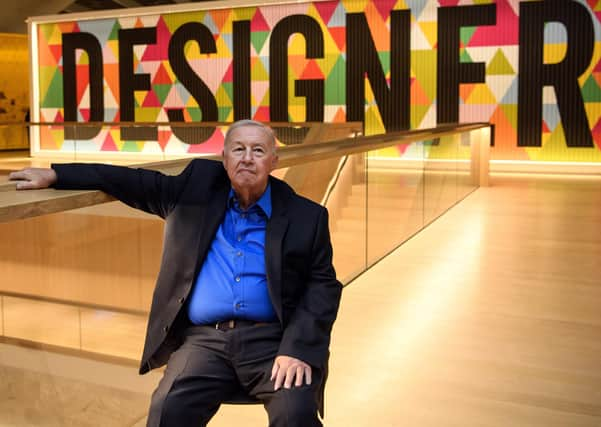Obituary; Sir Terence Conran, pioneering British designer, retailer and restaurateur


Some of the items you use every day were probably brought to a high street near you by Sir Terence Conran.
There is the duvet, flat-pack furniture and back in the 1960s, a terracotta cooking bulb called a chicken brick which allowed the meat to cook in its own steam.
Advertisement
Hide AdAdvertisement
Hide AdTerence Orby Conran was born in Kingston-upon-Thames, Surrey, on October 4 1931, the son of Christina Halstead and Gerard Conran, who ran a rubber import works.
His businesswoman sister Priscilla Carluccio, who shares his eye for detail, helped to start the Carluccio’s cafe restaurant chain with her chef ex-husband Antonio Carluccio.
From the start of his career, Sir Terence’s focus ensured he would become more than a designer.
Being a natural salesman with strong communication skills, he grew up to be a businessman who built a design, restaurant and retail empire plus an instantly recognisable brand name.
On a personal level, he became the head of a talented design dynasty.
His five children – Sebastian, Jasper, Tom, Sophie and Ned – from his four marriages have each forged successful careers in the creative sector.
Sir Terence said that being sent to Bryanston, a private boarding school in Dorset, was an “inspired” choice by his mother.
It was a place where practical skills such as digging a vegetable garden and woodwork were seen as being just as important as Latin.
Advertisement
Hide AdAdvertisement
Hide AdHe studied textile design at London’s Central School of Art and was an independent designer by the time he was 21.
Sir Terence set up a furniture-making business in an East End studio.
Artist Eduardo Paolozzi was a friend and he worked on the Festival of Britain.
His place as a master of modern British design stems from founding the Habitat high street chain.
It gave Britons, who were slowly recovering from the war, a new, modern look to their homes.
Small items were sold alongside large furniture and affordable modern design was on offer.
Firms such as Habitat, Heal’s and Mothercare have all been personally influenced by Sir Terence, and he created furniture for Marks & Spencer and JC Penney, bowls for Alessi and designs for Content by Conran.
He also set up the Conran Roche architecture practice in 1980.
Advertisement
Hide AdAdvertisement
Hide AdCookery, colour, eco design and storage are subjects among the dozens of books he has written.
He helped set up the Design Museum in 1989, at its original site near London Bridge.
It is billed as being devoted to contemporary design ranging from architecture and fashion to graphics, product and industrial design.
Sir Terenced said last yeare: “What I hope The Design Museum will do is to help produce a design world in the future, which is important to our country, not only our country, to other European countries.”
He also opened restaurants such as Le Pont de la Tour and Cantina del Ponte in the same region, leading him to be credited with having led the wider redevelopment of Butler’s Wharf at Shad Thames in the late 1980s and early 1990s.
Sir Terence was granted the honorary freedom of the London borough of Southwark in May 2016 for his role in the regeneration of the area.
The Conran Shop, which sells contemporary furniture, accessories and gifts, has stores in London, Paris, New York and across Japan.
Despite his wealth and success, Sir Terence continued to be involved in the business world in his later years.
Advertisement
Hide AdAdvertisement
Hide AdThe Soup Kitchen, which opened in 1953, was his first restaurant, while the Skylon restaurant was opened at the Royal Festival Hall in London in 2007.
He opened Boundary – a restaurant, bar and grill with a cafe and designer guestrooms – in a converted Victorian warehouse in east London in 2008.
Sir Terence’s commercial success also triggered media headlines about family feuds, who would inherit his empire, tales of clashing egos and bitter divorce.
Architect Brenda Davison became his first wife in 1954.
He later married Shirley Pearce, who wrote the Superwoman guide to living. She was also a bestselling novelist of titles such as Lace and Savages.
They had two children – Sebastian and Jasper – and divorced in 1962.
Food writer Caroline Herbert became his third wife a year later.
They had three children – Tom, Sophie and Ned – before the marriage ended in bitter divorce in 1996 and a reported £10.5 million settlement.
He married his fourth wife, property developer Victoria Davis, in 2000.
Advertisement
Hide AdAdvertisement
Hide AdSir Terence’s son Sebastian is an award-winning product designer, while fashion and homeware designer Jasper was the chairman and creative director of The Conran Shop.
His daughter Sophie is an interior designer and his other sons Tom and Ned are restaurateurs.
Sir Terence was knighted in 1983.
In a statement released by The Design Museum, his family described Conran as a “visionary” who “revolutionised the way we live in Britain.”
“At the heart of everything he did was a very simple belief that good design improves the quality of people’s lives,” his family said,
Tim Marlow, The Design Museum’s chief executive, said Conran was “instrumental in the re-designing of post-war Britain and his legacy is huge.”
“He changed the way we lived and shopped and ate,” he said.
Comments
Want to join the conversation? Please or to comment on this article.